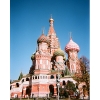|
 Every nation
is famous with something unique that is intrinsic to it. The same as France is known for Eiffel
Tower, Italy is
famous for the Pisa Tower and Egypt
–for the pyramids, Russia is
known for its St Basil's Cathedral which is located in the heart of Moscow, on the Red
Sqaure. The structure is unique in regards to architecture, though typically of
Russian style as the foreigners state, and yet the St Basil's Cathedral is the
sign of Russia. Every nation
is famous with something unique that is intrinsic to it. The same as France is known for Eiffel
Tower, Italy is
famous for the Pisa Tower and Egypt
–for the pyramids, Russia is
known for its St Basil's Cathedral which is located in the heart of Moscow, on the Red
Sqaure. The structure is unique in regards to architecture, though typically of
Russian style as the foreigners state, and yet the St Basil's Cathedral is the
sign of Russia.
Actually
the cathedral is not the one to honor St.Basl. The Feast of St. Mary Cathedral
(Pokrovsky
Cathedral) is located on the Red Square built in the middle of the 16th
century by the order of Ivan the Terrible to commemorate the seizure of Kazan. In the course of
marches against the Kazan
princedom around the stony Trinity church which was situated there before the
reign of Ivan the Terrible, after every war triumph a wooden chapel was built
to honor this or that saints. After the final win, the successful assault of Kazan,
the ruler ordered to build a new cathedral there of the incredible beauty to be
the only cathedral in the world.
The particular
confusion is observed with the chief architect for the Pokrovsky Cathedral.
During the Soviet Union reign, the version was
accepted in the population that the masters called Barma and Postnik were those
who built the masterpiece of Russian architecture. There was the legend that
Ivan the Terrible, upon completion of construction, realized he had an
incredibly beautiful cathedral and he caused the architects become blind to
prevent them from constructing something like that.
Presently the historians tend
to adopt the version that there was the only architect called Ivan Yakovlevich
Barma, aka Postnik (Feaster) since he was adherent to all Orthodox feasts. And the
legend of making him blind is not proved since the blind architect could never
had finished construction of several cathedrals that were erected just after
the St. Basil Cathedral was completed, officially announced as June 29, 1561.
The great restoration to strengthen the back is needed that wall affected as
the result of Moscow
occupation by Napoleon in 1817. After the October Revolution there was the
threat to demolish the Pokrovsky Cathedral and in 1930 the opportunity of
demolition was seriously discussed as if it prevented the auto traffic. In the end
the common sense prevailed and the treasure of the national culture was
reserved.
Considering
the structure as the legend of architecture, the St. Basil’d Cathedral is
presented as nine different churches with eleven altars (two of them were built
in the course of further reconstruction works) located on the entire
foundation. The central altar which gave the official name to the cathedral is called
Pokrovsky Cathedral, the northern one is called in favor of the Sts. Adrian and
Natalia, Ms., the northeastern structure is named after St. John the
"Almoner", the eastern is known as Trinity, the southeastern favors Saint
Alexander Svirsky, the south is built for St. Nicholas the Wonderworker, the southwestern
cathedral is for Saint Barlaam of Khutyn, the western is known as for Entry of
Christ into Jerusalem, the northwestern is to honor the Saint Gregory the
Illuminator of Armenia. In 1588 the compass of St.Basil was added and in 1672 -
Laying the Veil (since 1680 it is known as Nativity of Theotokos, and since
1916 as Saint John
the Blessed of Moscow. The compasses were connected with each other with the system
of passages and each church is crowned with the bulb-shaped dome, each of tem
differing from one another. Apart from the magnificent exterior, the architectural
and composition beauty and unique look of the Cathedral with the height of 65
meters is that the structure has no distinct front and it is impossible to
define at first sight which is front and which is back side since the structure
is frontal to every side you are.
Since 1991 года, in 60 year’s interval, the regular
divine services are held in Pokrovsky Cathedral though it still keeps the
status of the branch at the State Museum of History entered in the list of
objects of the UNESCO World Heritage.
|